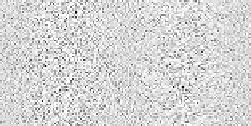Cryptography Reference
In-Depth Information
(a) Shadow 1
(b) Shadow 2
(c) Shadow 1+Shadow 2
FIGURE 17.2
A (2, 2)-GVCS of h = 1;l = 0, and m = 2: (a) and (b) two shadows (c) the
reconstructed image.
gray subpixels replaced the black subpixels. Hence, GVCS holds the contrast
and security conditions (V-1) and (V-2), and it is still a VCS. In this chapter,
we use the notation (k;n;m;g)-GVCS, to denote a (k;n)-GVCS with B
0
1
and
B
0
0
, in which every row has g gray subpixels and (mg) white subpixels. The
whiteness, (mg) white subpixels in every m-subpixel block, can be used to
distinguish the black color from the white color. In GVCS, the grayness of
the nonwhite subpixels in the reconstructed image is different from the pure
blackness in the VCS, and it will distort the clarity (see
Figure 17.1(d)
and
Figure 17.2(c)).
In order to design a TiOISSS based on GVCS and PISSS, we should care-
fully observe the distinguishing characteristics of both image secret sharing
schemes. All characteristics of GVCS and PISSS are opposite; hence, combin-
ing GVCS and PISSS creates the following problem. It is obvious that we need
two secret images|a halftone secret image for GVCS and a gray-level secret
image for PISSS. In our TiOISSS, the gray-level secret image is shared by
PISSS. Then, we divide the halftone secret image into shadows by GVCS, in
which the grayscale values in B
0
1
and B
0
0
are chosen according to the outputs
of the (k 1)-degree polynomials in PISSS. Also, we need to determine the
sizes of both secret images such that there are enough gray subpixels in GVCS
to represent the outputs of PISSS.










Search WWH ::

Custom Search